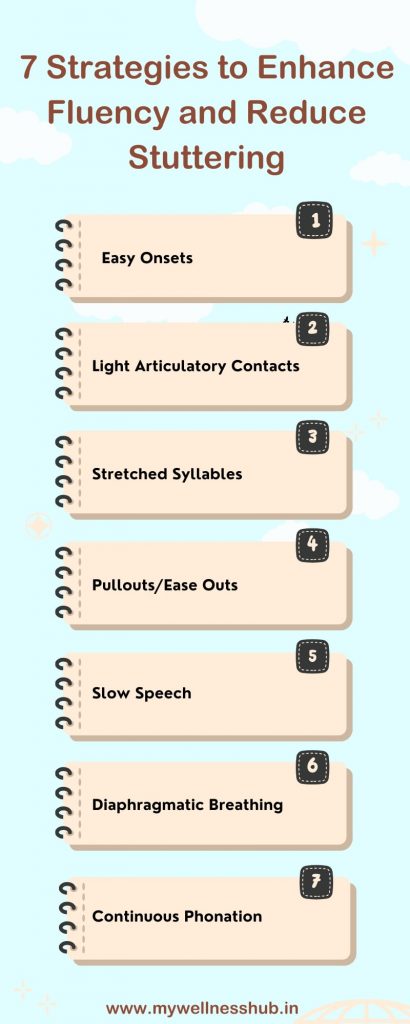Top 5 Strategies to Enhance Fluency and Reduce Stuttering
Last Updated: June 17, 2024
Stuttering, often referred to as stammering, can significantly impact a person’s ability to communicate effectively. This speech disorder makes it challenging to express thoughts clearly, leading to frustration and a sense of losing control over one’s own speech. Whether you’re a child or an adult, stuttering can interfere with daily interactions, making social situations daunting and sometimes causing individuals to withdraw from conversations altogether.
Improving fluency is not just about speaking more smoothly; it’s about regaining confidence and enhancing overall communication skills. Better fluency can lead to more positive social interactions, increased participation in work or school activities, and a boost in self-esteem. This article will cover seven effective strategies designed to enhance fluency and reduce stuttering. These techniques can help you or your loved one gain better control over speech and improve the quality of daily communication.

Strategy 1: Easy Onsets
Easy onsets are a powerful technique designed to reduce tension in the vocal folds, which can help to enhance fluency and reduce stuttering. When you stutter, tension often builds up in your vocal folds, making it difficult to start speaking smoothly. Easy onsets work by gently easing into the beginning sounds of words, particularly those that start with a vowel.
Steps to Practice Easy Onsets
- Take a Deep Breath: Begin by taking a deep, relaxing breath. This helps to prepare your vocal folds for smooth speech.
- Slowly Exhale with a Gentle /h/ Sound: As you start to exhale, let out a small, gentle /h/ sound. This initiates a gentle airflow and keeps the vocal folds relaxed.
- Gradually Increase Your Voice to a Normal Speaking Level: Once you’ve started with the gentle /h/ sound, gradually increase your voice volume to your normal speaking level.
Example: Using the Word “Apple”
Let’s say you want to say the word “apple.” Start by taking a deep breath, then exhale slowly while making a gentle /h/ sound. Begin the word softly: “hhhhHHHHapple.” Over time and with practice, the /h/ sound will become less pronounced, and the transition into the word will feel more natural.
Tip: Practice Regularly
To make this technique effective, it’s important to practice regularly. The more you practice, the more natural and automatic it will become. Try using easy onsets in various speaking situations, starting with simpler words and gradually progressing to more complex sentences.
Strategy 2: Light Articulatory Contacts
Light articulatory contacts are a technique used to reduce tension in the lips, teeth, and tongue, which can significantly help in preventing stuttering. When we speak, the articulators—lips, teeth, and tongue—often exert too much pressure, leading to tension and, consequently, stuttering. By using lighter contacts, you can reduce this tension and improve the smoothness of your speech.
Steps to Practice Light Articulatory Contacts
- Identify the Articulator Involved in a Sound: Determine which part of your mouth is used to make a particular sound. For instance, when saying the /t/ sound, the tongue taps the area behind the front teeth.
- Use the Lightest Touch to Produce the Sound: Practice producing the sound with as little pressure as possible. This means lightly touching the articulator involved.
Example: Producing the /t/ Sound
To demonstrate, let’s use the /t/ sound. Typically, you make this sound by tapping the tongue behind your front teeth. Try saying the /t/ sound three times in a row, each time with lighter pressure. By the third time, your tongue should barely touch the back of your teeth but just enough to make the sound.
Tip: Practice with Different Sounds
To get comfortable with light articulatory contacts, practice with a variety of sounds. This will help you become more adept at reducing tension across different words and phrases. Over time, you’ll find that your speech becomes more fluid and less prone to stuttering.
Know more: Articulation Disorder in Children: Signs, Causes & Treatment
Strategy 3: Stretched Syllables
Stretched syllables is a technique that helps prevent stuttering by slowing down your speech and reducing the pressure to speak quickly. By breaking words into syllables and stretching each one, you can gain better control over your speech and reduce instances of stuttering.
Steps to Practice Stretched Syllables
- Break Words into Syllables: Start by identifying the syllables in each word you plan to say. This helps in focusing on each part of the word separately.
- Stretch Each Syllable for About Two Seconds: As you say each syllable, stretch it out for approximately two seconds. This slower pace allows you to articulate each part of the word more clearly and with less tension.
Example: Using the Word “Singer”
Take the word “singer” and break it into its syllables: “sing-er.” Now, stretch each syllable: “sssiiingeeerrr.” By elongating the syllables, you reduce the rush to get the word out, which can help prevent stuttering.
Tip: Consistent Practice
While it may feel unnatural at first, consistent practice of stretching syllables can make a significant difference. Over time, this technique will help you develop a more natural rhythm in your speech, making it smoother and more fluent.
Read more: Understanding Speech Impediments: Causes, Types & Treatment
Strategy 4: Slow Speech
Slowing down your speech is an effective strategy to improve fluency and reduce stuttering. Speaking slowly allows you to articulate each word more clearly, reducing the pressure to rush through sentences and helping to maintain control over your speech.
Benefits of Slowing Down Speech
By taking the time to slow down your speech, you can:
- Reduce Tension: Slower speech reduces the physical tension in your speech muscles, which can prevent stuttering.
- Improve Clarity: Speaking slowly ensures that each word is pronounced clearly, making it easier for listeners to understand you.
- Increase Confidence: As you gain control over your speech, your confidence in speaking situations will naturally improve.
Steps to Practice Slow Speech
- Add Small Pauses Between Words: When speaking, consciously add brief pauses between each word. This helps to break up your speech into manageable parts and reduces the rush to finish sentences.
- Elongate Vowels and Sounds in Words: Stretch out the vowels and other sounds in your words. For example, instead of saying “cat” quickly, try saying it slowly as “caaaat.” This elongation helps you focus on each sound and maintain control.
Tip for Parents: Model Slow Speech for Children
If you are a parent or caregiver, one of the best ways to help a child who stutters is to model slow speech yourself. Children often mimic the speech patterns they hear, so speaking slowly and clearly can encourage them to do the same. Make your conversations with them an opportunity to practice this technique in a supportive environment.
Learn more: 10 Myths About Stuttering: Facts & Support
Strategy 5: Diaphragmatic Breathing
Diaphragmatic breathing, also known as abdominal or deep breathing, is a highly effective technique to support fluent speech. Proper breathing techniques can help control airflow, reduce tension, and provide a stable foundation for speaking. By focusing on breathing from the diaphragm rather than the chest, you can maintain a more relaxed state, which is crucial for smooth and fluent speech.
Steps to Practice Diaphragmatic Breathing
- Place One Hand on Your Chest and One on Your Belly: This helps you feel the difference between shallow chest breathing and deep diaphragmatic breathing.
- Take Deep Breaths, Feeling Your Belly Rise and Fall: Inhale deeply through your nose, allowing your belly to rise as it fills with air. Your chest should remain relatively still. Exhale slowly through your mouth, feeling your belly fall.
Tip: Practice Regularly
Making diaphragmatic breathing a habit requires regular practice. Set aside a few minutes each day to focus on your breathing. Over time, this technique will become more natural and can be easily incorporated into your speaking routine.
Comparison of Techniques
| Technique | Key Benefit | Practice Tips |
|---|---|---|
| Easy Onsets | Reduces tension in vocal folds | – Practice with words that start with vowels. – Take a deep breath, and exhale slowly with a gentle /h/ sound. |
| Light Articulatory Contacts | Reduces tension in articulators | – Use a light touch with the lips, teeth, and tongue. – Focus on making gentle contact when producing sounds. |
| Stretched Syllables | Slows down speech | – Break words into syllables. – Stretch each syllable for about two seconds. |
| Pullouts/Ease Outs | Manages stuttering during speech | – Identify the point of tension during a stutter. – Release the tension and continue speaking smoothly. |
| Slow Speech | Improves clarity and reduces rush. | – Add small pauses between words. – Elongate vowels and sounds in words. |
| Diaphragmatic Breathing | Controls airflow and maintains relaxation. | – Practice deep abdominal breathing. – Place one hand on your chest and one on your belly to monitor breathing. |
| Continuous Phonation | Maintains a steady flow of speech | – Keep the voice “turned on” with continuous airflow. – Reduce breaks between words by maintaining a steady flow of sound. |
Also read: 7 Key Techniques for Overcoming Stuttering
When to Seek Professional Help
While many individuals can manage stuttering with practice and techniques, there are times when professional speech therapy is necessary. Recognizing the signs that indicate the need for expert intervention is crucial for effective treatment and improvement.
Signs That Professional Speech Therapy Might Be Needed
- Persistent Stuttering: If stuttering continues beyond the age of five or starts to worsen, it might be time to consult a speech therapist. Early signs of persistent stuttering include prolonged repetitions, frequent hesitations, and visible frustration while speaking.
- Impact on Daily Life: When stuttering begins to affect daily activities, such as participating in school, work, or social interactions, professional help can provide significant benefits. Avoiding conversations or showing reluctance to speak in public are clear indicators.
- Emotional Distress: If stuttering causes emotional distress, such as anxiety, embarrassment, or low self-esteem, seeking help from a speech therapist can address both the speech and emotional challenges associated with stuttering.
- Physical Strain: Noticeable physical strain or effort during speech, such as tensed facial muscles or irregular breathing patterns, can signal the need for professional evaluation and intervention.
The Benefits of Early Intervention
Early intervention can be highly beneficial in managing stuttering effectively. Speech therapy can provide tailored strategies and support to improve fluency and confidence. The sooner therapy begins, the better the outcomes, especially for young children who are still developing their communication skills.
Signs for Professional Help
| Sign | Description |
|---|---|
| Persistent Stuttering | Stuttering that continues beyond the age of five and worsens over time. |
| Impact on Daily Life | Stuttering affects participation in school, work, or social situations. |
| Emotional Distress | Stuttering causes anxiety, embarrassment, or low self-esteem. |
| Physical Strain | Noticeable tension or effort during speech, such as tensed facial muscles or irregular breathing patterns. |
Conclusion
In this article, we’ve explored seven effective strategies to enhance fluency and reduce stuttering. These strategies include easy onsets, light articulatory contacts, stretched syllables, pullouts/easeouts, slow speech, diaphragmatic breathing, and continuous phonation. Practicing these techniques regularly can significantly improve speech fluency and boost confidence in communication. Consistency is key – the more you practice, the more natural these techniques will become, helping you achieve smoother and more fluent speech.
At Wellness Hub, we offer a range of resources and support for speech and language therapy. Our expert advice and tools are designed to guide you through your journey to better speech. For more tips and comprehensive resources, explore our speech therapy guides. By integrating these strategies into your daily routine, you can take meaningful steps towards improving your speech fluency and reducing stuttering. Keep practicing, stay patient with yourself, and remember that help and support are always available at Wellness Hub.
Frequently Asked Questions:
1. What are some effective strategies to reduce stuttering?
Several effective strategies can help reduce stuttering, including easy onsets, light articulatory contacts, stretched syllables, pullouts/easeouts, slow speech, diaphragmatic breathing, and continuous phonation. Practicing these techniques regularly can improve speech fluency and boost confidence.
2. How can easy onsets help with stuttering?
Easy onsets help reduce tension in the vocal folds by gently easing into the beginning sounds of words. This technique involves taking a deep breath, slowly exhaling with a gentle /h/ sound, and gradually increasing your voice to a normal speaking level.
3. What is the role of light articulatory contacts in speech fluency?
Light articulatory contacts reduce tension in the lips, teeth, and tongue by using a light touch to produce sounds. This technique helps prevent stuttering by ensuring that the articulators do not exert too much pressure.
4. How do stretched syllables improve speech fluency?
Stretched syllables involve breaking words into syllables and stretching each one for about two seconds. This slower pace allows for better control over speech and reduces the likelihood of stuttering.
5. Why is slow speech beneficial for stuttering?
Slowing down speech by adding small pauses between words and elongating vowels and sounds helps reduce tension and improve clarity. This technique allows speakers to maintain control and avoid rushing through sentences.
6. How does diaphragmatic breathing support fluent speech?
Diaphragmatic breathing, or deep breathing, involves using the diaphragm to control airflow. This technique reduces physical tension, maintains a relaxed state, and provides a stable foundation for smooth speech.
7. When should I seek professional help for stuttering?
Professional help should be sought if stuttering persists beyond the age of five, worsens, impacts daily activities, causes emotional distress, or involves noticeable physical strain. Early intervention with a speech therapist can be highly beneficial.
8. Can practicing these strategies at home make a difference?
Yes, practicing these strategies regularly at home can significantly improve speech fluency. Consistency and patience are essential for making these techniques an effective part of your speaking routine.
9. Where can I find resources and support for speech and language therapy?
Wellness Hub offers a range of resources and support for speech and language therapy. Visit Wellness Hub for expert advice and comprehensive guides to help you on your journey to better speech.
10. How can continuous phonation improve speech fluency?
Continuous phonation involves maintaining a steady flow of air and sound while speaking, similar to how we sing. This technique helps keep the voice “turned on” and reduces breaks between words, which can significantly improve fluency and reduce stuttering.
About the Author:
Anuradha Karanam
Speech-language pathologist (7+ years of experience)
Anuradha Karanam is a skilled speech-language pathologist with over 6 years of experience. Fluent in Tamil, Telugu, Hindi, and English, she specializes in parent counseling, speech sound disorders, fluency assessment, and speech-language evaluations. Anuradha excels at working with children with developmental disorders, offering creative and effective therapy programs. Currently, at Wellness Hub, she holds a BASLP degree and is registered with the RCI (CRR No A85500). Her patience, ambition, and dedication make her a trusted expert in her field.
Connect with Anuradha to learn more about how she can help you or your loved one find their voice.
Book your Free Consultation Today
Parent/Caregiver Info:
Client’s Details:
* Error Message









